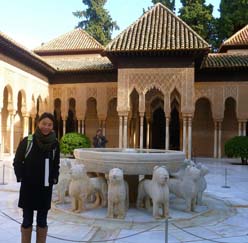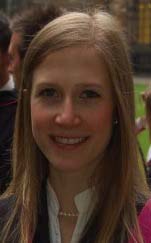|
 |
Sunjin Lee in Court of Lions at
the Alhambra, Granada, Spain |
Where are you doing your postdoc?
SL: I work in
Scott Weatherbee's lab at Yale in the Genetics department.
What is your current research about?
SL: We discovered a novel gene, which is critical for regulating proper stem cell proliferation and differentiation in the skin and appears to exert its function by keeping p63 levels in check. We are currently in the process of trying to elucidate the molecular mechanisms how p63 levels are regulated and how the defects we observe in the embryo arise.
What was the highlight of your trip to Granada (science or otherwise)?
SL: One of the
highlights was visiting the Alhambra and the
historic El Albayzin neighborhood. Our guide was
organized by SEBD and gave us a super-enthusiastic
but also very informative tour through the Albayzin
district- it was great!
What were your three favorite talks at the SEBD meeting? Why?
SL: Considering that this meeting was relatively small, I was surprised by the breadth and variety of the topics. I enjoyed many many talks, but these three were among those that stood out for me: Javier Lopez-Rios from
Rolf Zeller's lab gave a very interesting talk about the underlying mechanisms for digit reduction in cows. Limb patterning and development is of particular interest to our lab, though we study mainly polydactyly or the formation of extra digits. So it was great to hear Javier talk about mechanisms resulting in digit loss, which we don't know much about yet. Manuel Irimia
[Benjamin
Blencowe's lab] presented amazing work on embryonic stem cell-specific alternative splicing and it's role in reprogramming. It's a new layer of complexity on top of the mere presence of key transcription factors and specific epigenetic marks, which I find very interesting. And thirdly,
Oscar Marin's talk, which demonstrated mechanisms of building the surface of the cerebral cortex. It was a great talk but I was captivated the most by his beautiful live imaging of migrating Cajal-Retzius cells in live mouse embryos (how cool is that!).
What did you learn from your experience at the SEBD meeting?
SL: Be humble. Work hard. Drink wine. (We were in Spain after all).
What are your future plans?
SL: I tremendously enjoy what I am doing right now and would like to continue to do research and we are thinking of settling down in Europe, where my husband and I are from. But let's publish first and then see...
|
|
 |
Elizabeth Rideout
|
Where are you doing your postdoc?
ER: I am in the third year of a postdoctoral fellowship in the Dept. of Biochemistry and Molecular Biology at the University of Calgary in
Savraj Grewal's lab.
What is your current research about?
ER: I study how cell and
organismal growth are regulated in response to
environmental cues, such as nutrition, in the fruit
fly Drosophila melanogaster. Specifically, I study
how the control of tRNA synthesis by a
nutrient-responsive signaling pathway, the
Target-of-Rapamycin (TOR) pathway, influences
protein synthesis and consequently growth.
What was the highlight of your trip to Granada (science or otherwise)?
ER: I really appreciated
the opportunity to interact and share data with
colleagues from further abroad. Also, the meeting
venue and location were beautiful!
What were your three favorite talks at the SEBD meeting? Why?
ER: I really enjoyed the
talks by Andres Garelli [María Dominguez Castellano's
lab], Manuel Irimia
[Benjamin
Blencowe's lab]
and
Oscar
Marin. In the case of Andres Garelli and colleagues,
they identified a secreted factor in flies that
allows damaged or slow growing tissues in Drosophila
to communicate their impaired growth status to other
tissues. What I found really intriguing is that this
same factor is also used during normal development
to maintain bilateral symmetry. It will be
interesting to see if similar mechanisms operate in
other organisms.
What did you learn from your experience at the SEBD meeting?
ER: Attending the
meeting reinforced the importance of traveling to
international meetings to encourage the exchange of
knowledge between researchers, and to learn about
emerging techniques.
.
What are your future plans?
ER: I hope to establish
a research program using Drosophila as a model
system to understand how different tissues
co-operate to regulate metabolism and growth in
response to environmental or hormonal cues. |